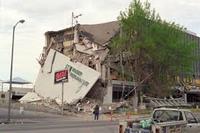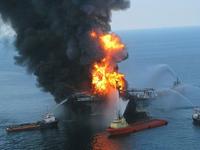-
Security of dirty bomb materials in U.S. inadequate: experts
There are more than 5,000 medical and research devices in the United States containing high-activity radiation sources, including 700 with category-1 sources. Category-1 radiation material could be used by terrorists in dirty bombs. The security measures developed by the industry were written with accident prevention in mind, not in order to thwart a deliberate, forcible effort by terrorists or criminals to gain control of the toxic material. In addition, radioactive materials were considered to be “self-protecting,” because it was assumed that the powerful radiation would deter anyone thinking of tampering with these devices. Terrorist bomb-makers, however, showed themselves to be more technologically-savvy than earlier thought, and, in any event, suicide bombers would not be deterred by the risk of radiation poisoning.
-
-
Most of Libya’s chemical weapons destroyed
When Libya joined the Chemical Weapons Convention in December 2003, it reported to the Organization for the Prohibition of Chemical Weapons (OPCW) that it was operating three chemical-weapons production facilities, and that it had produced a total of twenty-five tons of sulfur mustard gas, 3,563 bombs with warfare agents, and 1,390 tons of precursor materials. Over the next eight years, these chemical weapons stock were systematically destroyed under international supervision. The work was halted between February and November 2011 – the beginning of the rebellion against Qaddafi and his departure from power – and resumed in early 2012. OPCW announced than on 26 January 2014, work on destroying Libya’s mustard gas has been completed. The question is whether the Qaddafi regime was truthful in its 2003 declaration – or whether there are still stocks of chemical agents stashed somewhere in desert caches.
-
-
NSF rapid response research grants to fund study of West Virginia chemical spill
On 9 January 2014, crude 4-methylcyclohexane methanol (MCHM), a chemical primarily used to clean coal, leaked from a storage tank near Charleston, West Virginia, and bled into a river upstream of a water-treatment plant. As a result, about 15 percent of the state’s residents were advised not to drink the water. Better to understand the properties of the chemical that contaminated the drinking water, and the plumbing and water-treatment systems surrounding the area, the National Science Foundation (NSF) has awarded Rapid Response Research (RAPID) grants to research teams at three universities. These grants also will provide STEM learning opportunities for undergraduate and graduate students on the research teams.
-
-
Nuclear physicists prove a Peggy Guggenheim Collection painting is a fake
For more than forty years now, art experts and researchers have been trying to determine whether a painting in the Peggy Guggenheim Collection in Venice was a genuine painting which the French artist Fernand Leger produced between 1913 and 1914 as part of his “Contraste de Formes” series. Scientists from the Instituto Nazionale di Fisica Nucleare (INFN) in Florence have used, for the first time in the art world, a brand new carbon 14 dating method — the so-called “bomb peak” curve, which measures the presence of C-14 in the atmosphere — to establish that the canvas used in the painting was produced in 1959, and thus could not have been used by Leger, who died in 1955.
-
-
Growing body of evidence connects lead’s deleterious effects to criminal behavior
Violent crimes had reached an all-time high in the United States in the early 1990s, but by the end of the decade, the homicide rate had plummeted by more than 40 percent. Many theories were offered to explain this dramatic decline, but a new explanation is gaining credence: the banning of lead from gasoline and paint in the early 1970s. Babies born post-ban were exposed to far less lead – with its proven contribution to lowering IQ and causing attention problems and antisocial tendencies — and twenty years on, these babies became young adults who committed fewer crimes than their predecessors.
-
-
Quake-vulnerable concrete buildings in Los Angeles area identified

Researchers have identified nonductile concrete buildings constructed before roughly 1980 in the Los Angeles area. This category of buildings is known from experience in previous earthquakes to have the potential for catastrophic collapse during strong earthquakes. Nonductile concrete buildings were a prevalent construction type in seismically active zones of the United States before the enforcement of codes for ductile concrete which were introduced in the mid-1970s. A companion study estimates that approximately 17,000 nonductile reinforced concrete buildings are located in the most highly seismic areas of California. More than seventy-five million Americans in thirty-nine states live in towns and cities at risk for earthquake devastation.
-
-
Smartphones to help find avalanche victims
Not a winter goes by without an avalanche incident. In the search for those buried beneath the snow, every second counts. On average, rescuers have fifteen minutes to recover victims alive. This is why an avalanche transceiver is an essential piece of kit for anyone spending significant time off-piste. These transceivers do not come cheap, however, ranging in price from 200 and over 500 euros — perhaps one reason why many walkers and skiers still do not carry one with them. Now smartphones equipped with functions of an avalanche transceiver should help locate the victims quickly.
-
-
Chemical, physical traits of post-nuclear detonation fallout identified
Post-detonation nuclear forensics relies on advanced analytical techniques and an understanding of the physio-chemical processes associated with a nuclear detonation to identify the device type and the source of the nuclear material in the device. Researchers have begun to develop a technique that provides a practical approach for looking into the complex physical and chemical processes that occur during fallout formation following a nuclear detonation.
-
-
The 9 January chemical leak in West Virginia is the latest in a long history of industrial accidents
The chemical spill that affected the water source in nine West Virginia counties in early January is part of a long history of industrial accidents resulting from the concentration of chemical and coal-mining operations in the region. The 9 January spill, which saw coal-cleansing chemical which leaked from Freedom Industries’ storage tank into the Elk River, leaving more than 300,000 residents without access to clean tap water for days, is the latest in a history of pollution which has poisoned groundwater, spewed toxic gas emissions, and caused fires and explosions.
-
-
Federal, state chemical safety agencies increasingly hampered by budget cuts
The budgets of state and federal agencies tasked with responding to the Elk River chemical spill have recently been cut, and these cuts have limited these agencies’ ability to prevent or respond to disasters such as the water crisis in West Virginia. “We do less,” said a CDC financial official, when asked the results of cuts. “What [the CDC director] has often been quoted as saying is that threats are not going down and so it is concerning to not be able to grow with the public health threats.”
-
-
“Space cops” to help control traffic in space, prevent satellites from colliding

Collisions in space of satellites and space debris have become increasingly problematic. A team of scientists are using mini-satellites that work as “space cops” to help control traffic in space. The scientists used a series of six images over a 60-hour period taken from a ground-based satellite to prove that it is possible to refine the orbit of another satellite in low earth orbit.
-
-
Faster way to spot bacteria-tainted food -- and prevent illness
The regular appearance of food poisoning in the news, including a recent event that led to the recall of more than 33,000 pounds of chicken, drives home the need for better bacterial detection long before meats and produce make it to the dinner table.
-
-
New anthrax-killing virus could offer new ways to detect, treat, and decontaminate anthrax bacillus
From a zebra carcass on the plains of Namibia in Southern Africa, researchers have discovered a new, unusually large virus (or bacteriophage) which infects the bacterium that causes anthrax. The novel bacteriophage could eventually open up new ways to detect, treat, or decontaminate the anthrax bacillus and its relatives that cause food poisoning. Bacteriophages are often highly specific to a particular strain of bacteria, and when they were first discovered in the early twentieth century there was strong interest in them as antimicrobial agents. The discovery of penicillin and other antibiotics, however, eclipsed phage treatments in the West, although research continued in the Soviet Union.
-
-
Deepwater Horizon: Identifying harmful elements of persisting oil

Scientists are unraveling the composition of persisting oil residues collected from Gulf of Mexico beaches following the Deepwater Horizon disaster, insisting on further assessment of the toxic impact of these chemical remnants on the marine ecosystem. A new study targeted the most abundant compounds in the residual oil, dissecting their composition with unprecedented accuracy. This is important for understanding the environmental impact of persisting oil remnants, because ecotoxicologists have demonstrated that all three chemical groups can be harmful to living organisms. More worrisome, relatively little is known about the broader toxicity of saturates and oxygenated hydrocarbons in the marine ecosystem, like the Gulf of Mexico —where there are 223 offshore oil rigs — even though these compounds constitute most of the persisting oil.
-
-
Israel considering earthquake-proofing important Biblical-period structures
Israel is located in one of the world’s earthquake-prone areas, along the friction point of the African and Arabian tectonic plates.Officials in Israel are taking preventative measures to protect the country’s most important ancient sites from earthquake damage. Engineers from the University of Padua in Italy have installed sensors throughout the Tower of David, one of Jerusalem most important historical sites, to determine what sort of earthquake-proofing may be needed. Some experts opined that in the event of an earthquake, Jerusalem’s most ancient structures might actually be the city’s most dependable. “If they still stand after so many earthquakes during the last 2,000 years, they must be good structures,” one of them said.
-
More headlines
The long view
Keeping the Lights on with Nuclear Waste: Radiochemistry Transforms Nuclear Waste into Strategic Materials
How UNLV radiochemistry is pioneering the future of energy in the Southwest by salvaging strategic materials from nuclear dumps –and making it safe.
Model Predicts Long-Term Effects of Nuclear Waste on Underground Disposal Systems
The simulations matched results from an underground lab experiment in Switzerland, suggesting modeling could be used to validate the safety of nuclear disposal sites.
